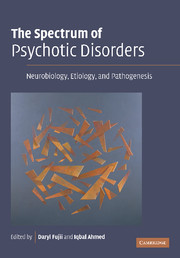Book contents
- Frontmatter
- Contents
- List of Contributors
- Preface
- Acknowledgements
- Part I Introduction
- Part II Primary Psychotic Disorders
- Part III Mood Disorders
- Part IV Neurodevelopmental and Genetic Disorders
- Part V Central Nervous System Disorders
- Part VI Substance Abuse and Medications
- 19 Cannabis-Induced Psychosis
- 20 Cocaine
- 21 Methamphetamine
- 22 Medication-Induced Psychosis
- Part VII Neurodegenerative Disorders
- Part VIII Sensory Impairments
- Part IX Conclusion
- Index
- References
22 - Medication-Induced Psychosis
from Part VI - Substance Abuse and Medications
Published online by Cambridge University Press: 06 January 2010
- Frontmatter
- Contents
- List of Contributors
- Preface
- Acknowledgements
- Part I Introduction
- Part II Primary Psychotic Disorders
- Part III Mood Disorders
- Part IV Neurodevelopmental and Genetic Disorders
- Part V Central Nervous System Disorders
- Part VI Substance Abuse and Medications
- 19 Cannabis-Induced Psychosis
- 20 Cocaine
- 21 Methamphetamine
- 22 Medication-Induced Psychosis
- Part VII Neurodegenerative Disorders
- Part VIII Sensory Impairments
- Part IX Conclusion
- Index
- References
Summary
Medication-induced psychosis is a common occurrence. Both in and out of the hospital, patients with multiple health problems are at an increased risk of developing both psychosis and delirium with the addition of prescription and over-the-counter medications. This chapter will define medication-induced psychosis, differentiate this disorder from delirium, and discuss the drug classes most often associated with psychosis. Unlike many forms of psychosis, medication-induced psychosis does not have specific long-term psychiatric symptoms, prodromes, positive versus negative symptoms, common brain neuropathology, or genetic factors. It is neither gender specific nor age specific. The sole risk of medication-induced psychosis lies in a patient's general risk of developing a medical problem that requires the use of drug therapy.
Many medications when taken at therapeutic doses are associated with the development of psychotic symptoms (Anonymous, 2002). There are few large studies to substantiate these relationships; instead we must rely on case studies. Because many of these same medicines can also cause delirium (Trzepacz & Meagher, 2005), it is necessary to differentiate “delirium” from “psychosis” as there is obvious overlap between the disorders. Differentiating between drug-induced psychosis and delirium can be difficult. This distinction appears to be at least historically ambiguous if not controversial. Some texts group delirium in with “secondary psychoses” whose characteristic features of “clouding of consciousness” and “fluctuating course” differentiate them from primary psychoses. Charlton and Kavanau argue that most psychiatric conditions, including primary mental illness as well as intoxications have a delirious component to the disease (Charlton & Kavanau, 2002).
- Type
- Chapter
- Information
- The Spectrum of Psychotic DisordersNeurobiology, Etiology and Pathogenesis, pp. 406 - 452Publisher: Cambridge University PressPrint publication year: 2007



